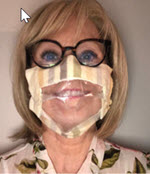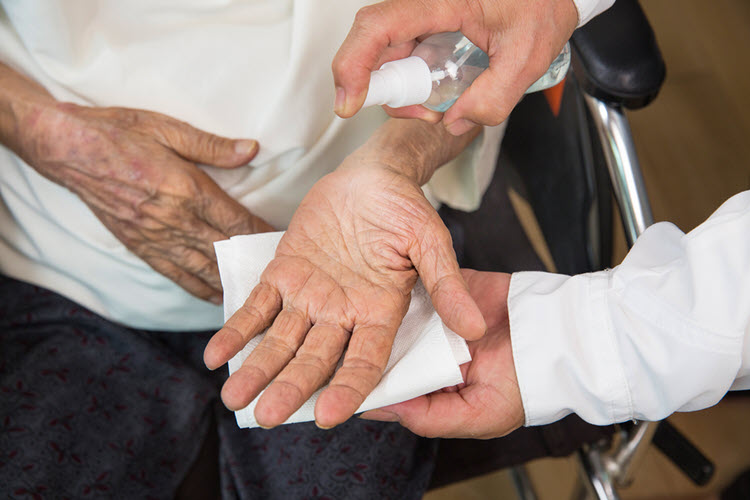Like everyone, I am concerned about our elders living in facilities during the Coronavirus outbreak.
Last week, we learned how COVID-19 has changed life in a Skilled Nursing facility. This week, the focus is on how Memory Care facilities are adapting.
Changes to daily routine
Staff and administration work every day to keep up and comply with CDC, state and local health department guidelines. Communications come in daily from these institutions and the organizations’ home office helps to implement them. The focus is to keep residents and team members healthy and safe. To help with these goals, there are additional education programs on health and wellness, conference calls with the department of health and additional reporting focused on team member and residents’ health.
When working with residents living with cognitive impairment, changes to their daily routine can get challenging. Language alone is problematic because so much of their communication is non-verbal. For safety, team members wear masks but that inhibits clues of good intention like a smile. Although they continue to approach from the front, make eye contact and have a reassuring big smile, the mask does not allow a resident to see their smile which cuts into the ability to communicate. Just telling someone “let’s get you into the shower” without them being able to see your entire face and a smile means a big part of the needed communication is missing.
When these non-verbal clues are missing, it can mean a resident is not fully connecting with staff. That non connection leaves a blank which results in them not understanding. That missed communication can translate into not being able to accomplish all the steps to a task like showering. Communication gets even more challenging when a resident is hard of hearing because, of course, they cannot see our lips.

Helping residents social distance
This is difficult on so many levels. Residents are at different stages in the disease and this impacts their understanding of social distancing. Some residents early in their disease are watching the news. They can comprehend what is happening with COVID-19 and it is easier to get the social distancing point across. However, getting compliance without intervention gets more difficult at the middle and later stages. Folks in the middle can still communicate but the information is not getting to the place in their brain in the way that it needs to for easy compliance. As the disease progresses, folks have a hard time understanding any verbal clues so any type of verbal direction is lost. Because it is important to “meet people where they are”, staff is constantly adjusting responses and interactions with each resident.
New policies and procedures
Limiting residents at a dining table to one or two people.
At one facility a resident tried to sit where they always had, but two residents were already there. This resident took very personally not being able to sit at their usual table. Because residents are memory and cognitively impaired, it is hard to get them to understand that the limit of two to a table is for their own good. Staff tried explanations, reassurance and distraction, but in that moment to lower agitation, the answer was to respect the individual’s right to go back to their suite. Giving this resident the freedom to make that choice resulted in them settling down. Later, in a calmer environment they were able to redirect “Oh look, we have a plate of dinner here, let’s sit and have a snack together,” and the resident ate dinner.
Keeping residents busy in smaller groups
Quarantine is difficult with the cognitively impaired. Keeping residents busy in smaller groups is one way to cut down on agitation and residents wanting to go elsewhere. Of course, the emphasis is on redirection, assurance and engaging each person in the activity to the best of their ability. Facilities that use a person-centered care model where they know the residents’ interests and hobbies can base these small group activities on ability and interest.
For example, for residents that like to bake, limiting the activity to 3-4 participants who sit further apart helps keep social distance. Because tasks are based on ability, each person gets a different tool, ensuring they have their own ‘job’. The biggest challenge is to get residents to stop sharing. One solution is to provide multiple sets of mixing spoons etc. so everyone has their own tools.
In art activities one-person can be painting on a canvas, while another tracing shapes. But as with baking, each person has their own paint brush, marker or safety scissors, they are sitting further apart and everything is disinfected after the activity.
Cherished programs go virtual
Of course, pet therapy is not as much fun virtually because you can’t pet the animals. With the program ‘Barnyard Babies’ accessed over Zoom, residents engage as they call out and ask to see the baby bunny, kitten or goat again. This program can customize the interaction to a community and residents can ask specific questions. Even live performances are available over the internet and many facilities are scheduling virtual performances with regular performers.
Procedures to keep residents and team members safe
Facilities are closed to visitors and many have hit the pause button on admitting new residents. Team members have masks and PPE equipment. There are quarantine processes in place where people can be isolated with team members in full PPE while test results are awaited.
Along with CDC-recommended disinfecting guidelines, many facilities go beyond in keeping the environment safe. Some even have aerostatic spray guns with a special air mist solution that kills viruses, bacteria and fungus. They are spraying down all surfaces and in between wiping down with Lysol.
Many of the changes memory care facilities are making can and should be adopted at homes if you care for a loved one living with dementia.
Disclaimer: The material in this blog is for educational purposes only. It is not intended to replace, nor does it replace, consulting with a physician, lawyer, accountant, financial planner or other qualified professional.
Deb is available as a caregiver consultant. She will answer the question: “Where do I start?” and find the resources to alleviate your stress. If you would like to invest a half hour to learn how she can help you, please contact her at: deb@advocateformomanddad.com

